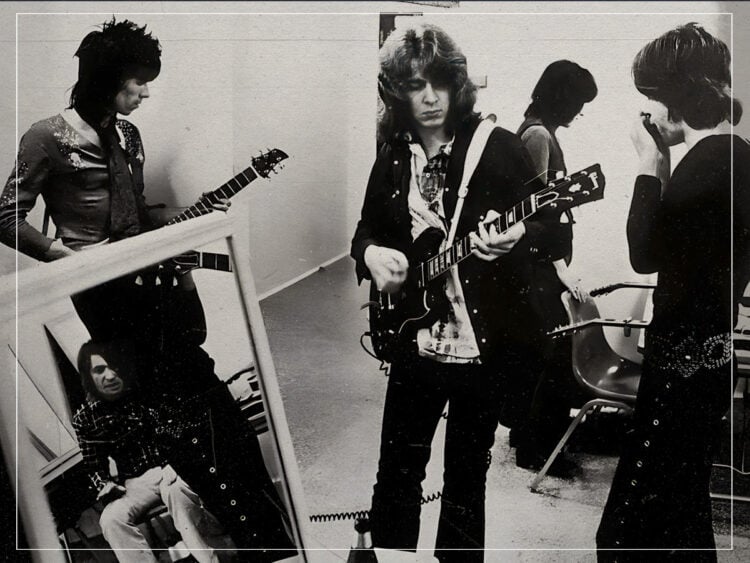News How a riff battle with Keith Richards became Mick Taylor’s finest moment
Approaching the end of the 1960s, The Rolling Stones reached the height of their power, with an impressive cache of number one singles in the locker. Although Keith Richards and Mick Jagger had met fierce competition from Paul McCartney and John Lennon, The Beatles were soon to disband, making way for the Stones’ tenure on the rock ‘n’ roll throne.
In May 1969, at the trough of Brian Jones’ downward spiral with drug addiction, the Stones sought a replacement to accompany Keith Richards as a lead guitarist. Uninspired and often too intoxicated to perform, Jones was absent during most of the Let It Bleed sessions. Fortunately, as Jones finally left the band in June 1969, Jagger and Richards had lined up a replacement.
Aged just 20, the young guitar virtuoso Mick Taylor, known for his prior work with John Mayall’s Bluesbreakers, joined the Rolling Stones. The youngster had been recommended to the band by John Mayall and Ian Stewart before blowing Richards away in a successful audition. “He just came up with line after beautiful line. What a player, man,” Richards recalled in a 2022 interview with Guitar World.
Taylor contributed to ‘Country Honk’ and ‘Live with Me’ during the closing sessions for Let It Bleed, but his most prominent work was still yet to come. After accompanying the Stones on their first US tour in three years, recordings from which would appear on the live album Get Yer Ya-Yas Out, the full force of Taylor’s talent could shine forth in Sticky Fingers.
Released in April 1971, Sticky Fingers was Taylor’s first full album with the Stones. His style made an immediate impact, heralding a new chapter in the band’s history; a delicate touch guided slower compositions like ‘Sway’, ‘Moonlight Mile’ and ‘Sister Morphine’, but this new chapter would be characterised by heavier rock anthems like ‘Brown Sugar’ and ‘Can’t You Hear Me Knocking’. The latter is often regarded as one of Taylor’s finest moments.
Recording engineer Andy Johns once described the Sticky Fingers sessions as the first time Taylor asserted his creative side. “I really think Mick Taylor had a big influence on the direction the band took,” he said. “They started working with Jimmy Miller… [and] obviously it got very much more rock and roll. Then Mick comes along, and it really sort of puts the icing on the cake. They went in that direction because they could start jamming again. They hadn’t been jamming for a long time.”
Crucially, both guitarists were fluid in their styles, but predominantly, Richards handled rhythm while Taylor played lead. After discovering their chemistry in the studio, the pair became quietly competitive, each showing the other their skills in protracted jams.
“I could sit and listen to Mick Taylor all night,” Johns added. “He would never make a mistake, and every take would be different. And he’d make you cry. It really was good… I loved listening to him play night after night after night. It was not boring.”
‘Can’t You Hear Me Knocking’ was a rarity for the Stones in that it wasn’t written during an improvisational jam: Jagger had his lyrics ready, and Richards had devised a chord progression. “They never used to go into the studio without any ideas,” Taylor once recalled, “but I can’t remember any occasions when they would actually go into the studio with a completely finished song, with words and everything.”
Although the song had unprecedented structure heading into the session, it gained much of its sultry groove on the day of recording thanks to Taylor’s creativity. As the session began, Richards introduced his choppy rhythm. “On that song, my fingers just landed in the right place, and I discovered a few things about that tuning that I’d never been aware of,” Richards remembered. “I think I realised that even as I was cutting the track.”
Following Richards’ lead, Taylor attacked the rhythm with his own contrasting yet highly complementary riff. Although the finished product sounded complex and dense, Richards pointed out that each respective part was relatively simple. “For a guitar player, it’s no big deal to play, the chopping, staccato bursts of chords, very direct and spare,” he said.
Although Taylor and Richards had enhanced each other’s performance through quiet competition, the result was enjoyed by all, especially Taylor. “Towards the end of the song, I just felt like carrying on playing,” Taylor remembered. The band took a break at the end of the planned composition but noticed their newest recruit still tinkering away on a Latin-inspired tangent. “It sounded good,” he continued, “so everybody quickly picked up their instruments again and carried on playing. It just happened.”
Thanks to Taylor’s creative zeal, ‘Can’t You Hear Me Knocking’ was transformed into a zesty seven-minute rock-out with its extended outro welcoming saxophone and conga overdubs. “Generally, I tried to bring my own distinctive sound and style to Sticky Fingers, and I like to think I added some extra spice,” Taylor reflected on his first album with the Stones. “I don’t want to say ‘sophistication’ – I think that sounds pretentious. Charlie said I brought ‘finesse.’ That’s a better word. I’ll go with what Charlie said.”




